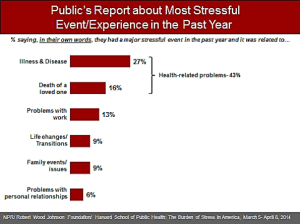 “Reality is the leading cause of stress among those in touch with it,” Lily Tomlin once quipped. Perhaps in 2014, America is the land of stress because we’re all so in touch with reality. THINK: reality TV, social networks as the new confessional, news channeling 24×7, and a world of too much TMI.
“Reality is the leading cause of stress among those in touch with it,” Lily Tomlin once quipped. Perhaps in 2014, America is the land of stress because we’re all so in touch with reality. THINK: reality TV, social networks as the new confessional, news channeling 24×7, and a world of too much TMI.
So no surprise, then, that one-half of the people in the U.S. have had a major stressful event or experience in the last year. And health tops the list of stressful events in This American Life in the forms of illness and disease (among 27% of people) and death of a loved one (for 16% of people).
The Burden of Stress in America, a survey from NPR, the Robert Wood Johnson Foundation (RWJF), and the Harvard School of Public Health, collected the stress-related insights of 2,505 U.S. adults 18 and older in March-April 2014.
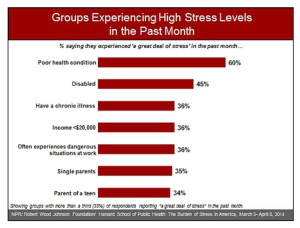 Stress is a chronic condition in the U.S.: stress and health go hand-in-hand. One-fourth of people had a great deal of stress in the past month: among those with the highest level of stress, 60% say they are in poor health, 45% are disabled, and 36% have a chronic illness.
Stress is a chronic condition in the U.S.: stress and health go hand-in-hand. One-fourth of people had a great deal of stress in the past month: among those with the highest level of stress, 60% say they are in poor health, 45% are disabled, and 36% have a chronic illness.
It’s no surprise to this health economist that financial problems are also a risk factor for overall stress: 53% of people reporting problems with money say they have a great deal of stress. Among people in poor health, 69% percent report financial problems. And people with lower incomes generally reported higher levels of stress.
Family problems contribute to stress, and caregiving is a contributor. 1 in 2 women reporting a great deal of stress say other family members’ health problems contributed to that stress versus 25% of men.
General activities of daily living — doing laundry, running errands, dealing with car problems, commuting to work, and the big one for 1 in 2 people — juggling schedules of family members — all contribute to stress among the stressful.
These then impact family life (for 75%), health (for 74%), work life (among 70%), and social life with friends (for 68%).
Tactically and more granularly, our daily lives are negatively impacted by stress in compromising our sleep (for 70% of people), eating less than usual (44%) and some eat more than usual (39%). Some folks exercise less (43%), and some have less sex than normal (40%), among other responses to stress.
Among those dealing with a great deal of stress, people have coping mechanisms: spending time with family and friends, meditating or praying, spending time outdoors, eating healthfully, exercising regularly, spending time with a pet, getting a full night’s sleep and spending time on a hobby, are the most popular tactics for dealing with stress. 36% of people with the highest stress levels use a prescription medication to deal with stress.
The study marks a major theme for RWJF focusing on a culture of health. In RWJF’s words,
We believe an American culture of health is one in which:
- Good health flourishes across geographic, demographic and social sectors.
- Being healthy and staying healthy is valued by our entire society.
- Individuals and families have the means and the opportunity to make choices that lead to healthy lifestyles.
- Business, government, individuals, and organizations work together to foster healthy communities and lifestyles.
- Everyone has access to affordable, quality health care.
- No one is excluded.
- Health care is efficient and equitable.
- The economy is less burdened by excessive and unwarranted health care spending.
- The health of the population guides public and private decision-making.
- Americans understand that we are all in this together.
Health Populi’s Hot Points: Most people realize that stress has a major impact on their health, family and work life, and most believe that stress has been problematic in the past but are optimistic for the future. Stress can sometimes be a positive force in life, 67% say.
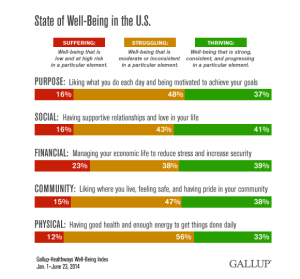
The last chart comes from the Gallup-Healthways Well-Being Index, measuring U.S. adults State of Well-Being for the first half of 2014. Note that 64% of people are struggling or suffering with respect to their sense of purpose (liking what they do each day and being motivated to achieve goals); 59% are struggling or suffering from poor social relationships; 61% aren’t thriving in their personal financial lives; 62% aren’t thriving in their community (with respect to safety, liking where they live, or having pride in their town); and 68% aren’t thriving in health.
Lily Tomlin’s point about being in touch with reality isn’t trivial – the third chart lists the top 10 daily events that contributed to stress in the past month for the most-stressed people. Note that 44% say hearing about what politicians and government are doing, and 40% say listening to the news, contribute to stress. 14% of people note that using social media contributes to stress.
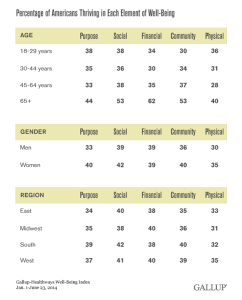 In 2014, RWJF found that The American Life is marked with stress across all age groups. But interestingly, Gallup-Healthways data indicates that older people 65+ rank higher on all five aspects of well-being: purpose, social, financial, community and physical. Yes, physical.
In 2014, RWJF found that The American Life is marked with stress across all age groups. But interestingly, Gallup-Healthways data indicates that older people 65+ rank higher on all five aspects of well-being: purpose, social, financial, community and physical. Yes, physical.
We would be wise in our journey toward a culture of health to tap into the wisdom of our elders, who have the long-view perspective on hard knocks and history. And don’t forget: they also have Medicare and Social Security.


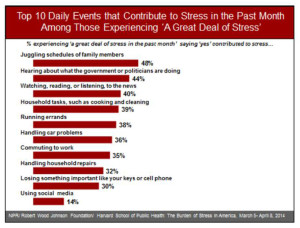


 I love sharing perspectives on what's shaping the future of health care, and appreciate the opportunity to be collaborating once again with Duke Corporate Education and a global client on 6th May. We'll be addressing some key pillars to consider in scenario planning such as growing consumerism in health care, technology (from AI to telehealth), climate change, and trust -- the key enabler for health engagement or dis-engagement and mis-information. I'm grateful to be affiliated with the corporate education provider
I love sharing perspectives on what's shaping the future of health care, and appreciate the opportunity to be collaborating once again with Duke Corporate Education and a global client on 6th May. We'll be addressing some key pillars to consider in scenario planning such as growing consumerism in health care, technology (from AI to telehealth), climate change, and trust -- the key enabler for health engagement or dis-engagement and mis-information. I'm grateful to be affiliated with the corporate education provider  Thank you FeedSpot for
Thank you FeedSpot for